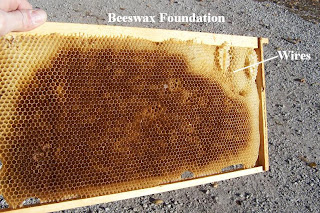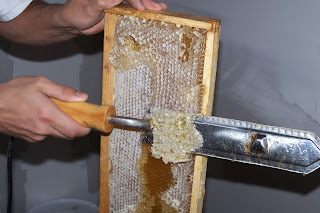Welcome to Long Lane Honey Bee Farms Online Lessons! Remember that you can click on each image to enlarge them.
To refresh your memory, the frames hold the foundation within the deep hive body or honey super.

When starting out keeping bees, the beekeeper must decide what type of foundation is best to use. In the past, there was only one kind, plain beeswax formed into thin layers of foundation with embedded wire to hold them in the frame. This type of foundation is still widely used. An additional wire has to be added horizontally to give the foundation strength. Otherwise, the heat of the hive will cause the thin layer of wax to fall out of the frame.
A small strip of wood is nailed to the top of the frame, catching little hooks on the wax to help it hang. These are commonly
referred to as split bottom and top wedge bar frames. This means that there is a top wedge bar of

wood that must be nailed to hold the wax, and that the bottom of the frame has a split piece of wood in which the thin layer of wax fits into and then is nailed.
Additional side pins are used as well. Sound complex? It is.

For the hobbyist who has one or two hives, it can be fun, spending time putting together all the little frame pieces and embedding wire into your wax. But for many, this has become too time consuming.
In addition to the pure wax foundation, we now have various types of plastic foundations:
Duragilt,
Plasticell,
Pierco,
Ritecell,
Permacomb and the option of an empty frame with no foundation at all.
Duragilt is a sheet of very thin clear plastic that is coated with beeswax and has the hexagonal worker cells embedded in the wax. Some beekeepers enjoy using
Duragilt and others do not like it. What's new :) I have tried
Durgilt and it proved unsuccessful for me. The bees drew it out unevenly or in small pockets. Rarely can I get an even frame of comb off of
Duragilt foundation.
I
like pure wax foundation, but I don't like the complexity of the assembly and how
venerable it is to mice and wax moths. So I've stopped using it. To reuse the frame means a lot of
disassembly and cleaning, pulling out nails, and removing the wires.
Permacomb is fully drawn plastic foundation, not wax comb. In other words, it is a plastic version of a fully drawn wax comb. It sound great as it would allow a fresh package of bees the ability to immediately start storing honey. I've never tried it due to the fact that it is expensive.
Then, there is plastic foundation by various names:
Ritecell,
Pierco and
Plasticell. This is my preference! This is a very thick piece of plastic, probably 1/8 inch think and has the
hexagonal worker cells embedded in the plastic. I use only the beeswax coated sheets of plastic. I love plastic foundation in wooden frames. I'm not as impressed with the one piece plastic frame and foundation. But my bees like it just the same. In fact, my queens love deep frames that are solid one piece plastic.
Here are the reasons I have gone totally to plastic:
1) Bees love it and pull it fast. I often entice them by spraying each sheet with sugar water2) It is VERY durable. You can scrap the comb off with a hive tool and never damage the cell.
3) Wax moths cannot destroy it.4) Mice cannot destroy it.5) It is very easy to spot eggs against the black brood sheets.6) You can spin it in an extractor at any speed and never blow it out.7) It doesn't droop in a hive or bow out.8) It snaps into frames rather than having to use wire and nail in a wedge.9) You can store it in any temperature.10) It is much more cost effective than constantly replacing damaged foundation.11) It can be shipped without damage in any temperature.There can be challenges with plastic. When there is not a strong nectar flow, bees can be slow in drawing out the comb on plastic. However, this is true with all foundation. Bees need nectar to produce wax to draw comb. One side of a frame can be drawn out into the empty side of the frame next to it. However, I have also seen this with wax foundation and especially with
Duragilt.The plastic foundation that we sell is coated with real beeswax, helping the bees to take to it better.
Also, be aware that different foundation types require matching frames. You cannot use wax foundation in a frame built to hold plastic. A frame that holds plastic foundation is known as a 'top and bottom groove frame' with a solid bottom.
During heavy nectar flow, we take several strips of plastic foundation, usually about 2" wide and place two or three in a frame. The bees will use this as a guide, modeling the worker cell grid and quickly adding their own wax in the gaps. Last summer, my son cut plastic foundation in the shape of his girlfriend's name and placed it into a frame in the hive. The bees pulled out the entire sheet. When you hold that frame up to the sun, you can see the name because the plastic shades the sun. But if you look directly at it, it just looks like drawn comb.
Can you put empty frames in a hive? Yes, and during a heavy nectar flow, the bees will make their own comb in the frame. However, this is a bit risky, as they could make it into drone comb. In fact, they usually do this if you place it on the outside edges of the frames, next to the hive walls. Foundation already has the worker size cell embossed in the plastic, so they simply pull out that same size cell. You can
experiment and see what you find. Also, it might take a few days longer, as they do have to
engineer the perfect
architectural design of the cells.
Drawing comb is so dependent upon the specific hive, the weather, and the nectar flow. So it is difficult to do a side by side test. But some claim that an empty frame is drawn out faster than a frame with foundation. I've never attempted a speed test.
A word or warning about intermixing frames. Don't mix plastic frames with wood frames within the same super. Keep all 10 frames the same.
Finally, regarding different types of foundation, we must consider the actual size of the individual cell. I like
Plasticell because it has a 4.9mm cell size, which I believe gives me better mite control. It has been suggested that due to the smaller size, the brood cell is capped before the mite can get inside.
Natural cell size is between 4.6mm and 5.0mm.
Pierco is 5.2mm.
Ritecell is 5.4mm.
PermaComb is 5.05. Bees from larger cells are larger bees and will keep building large cells. 'Regression' is a term referring to taking larger bees and regressing back to 4.9mm cell size. Below are three pictures each showing the different success I have with the different types of foundation. See you soon at the next lesson!





















.jpg)





0 comments:
welcome to my blog. please write some comment about this article ^_^